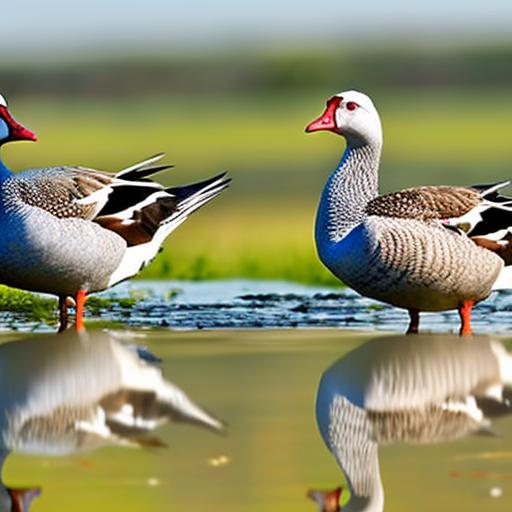Foxes are cunning and resourceful predators that pose a significant threat to small livestock, including chickens, ducks, and rabbits. Understanding their behavior and habits is crucial in developing effective strategies to protect your flock. Foxes are primarily nocturnal animals, meaning they are most active during the night. They are also highly adaptable and can thrive in a variety of environments, including rural, suburban, and urban areas. Foxes are opportunistic hunters and scavengers, preying on small animals such as rodents, birds, and insects. They are also known to raid chicken coops and other enclosures in search of easy meals. By familiarizing yourself with fox behavior and habits, you can better anticipate and prevent potential threats to your flock.
In addition to their nocturnal nature, foxes are also known for their intelligence and agility. They are skilled at digging, climbing, and jumping, making it essential to secure your flock with physical barriers and enclosures to prevent foxes from gaining access to your livestock. By understanding the threat posed by foxes and their behavior, you can take proactive measures to protect your flock and minimize the risk of predation.
Table of Contents
- 1 Securing Your Flock: Implementing Physical Barriers and Enclosures
- 2 Utilizing Guardian Animals: The Role of Livestock Guardian Dogs and Other Protectors
- 3 Implementing Deterrents: Using Scents, Sounds, and Visuals to Ward Off Foxes
- 4 Practicing Vigilance: Monitoring Your Flock and Surroundings for Signs of Fox Activity
- 5 Coexisting with Wildlife: Finding a Balance Between Protecting Your Flock and Respecting Local Ecosystems
- 6 Seeking Professional Help: When to Call in Experts for Assistance with Fox Management
Securing Your Flock: Implementing Physical Barriers and Enclosures
Implementing physical barriers and enclosures is a crucial step in protecting your flock from fox predation. Foxes are adept at finding and exploiting weaknesses in fencing and enclosures, so it’s essential to invest in high-quality materials and construction. Use sturdy wire mesh or hardware cloth with small openings to prevent foxes from squeezing through or digging under fences. Bury the bottom of the fence at least 12 inches deep and angle it outward to deter digging. Additionally, consider adding an electric wire at the top of the fence to prevent foxes from climbing over.
When designing enclosures for your flock, prioritize security by ensuring that all openings are securely latched and reinforced. Consider using predator-proof latches and locks to prevent foxes from gaining access to your coop or run. It’s also important to regularly inspect and maintain your fencing and enclosures to address any wear and tear or potential weak points. By implementing physical barriers and enclosures, you can create a secure environment for your flock and minimize the risk of fox predation.
Utilizing Guardian Animals: The Role of Livestock Guardian Dogs and Other Protectors
Livestock guardian dogs (LGDs) have been used for centuries to protect livestock from predators, including foxes. These specially bred and trained dogs are highly effective at deterring foxes and other predators through their presence, territorial behavior, and protective instincts. LGDs form strong bonds with the animals they protect and will actively patrol the perimeter of the flock’s territory, deterring potential threats. In addition to LGDs, other animals such as llamas, donkeys, and geese can also serve as effective protectors against fox predation.
When utilizing guardian animals, it’s essential to provide proper training, socialization, and care to ensure their effectiveness in protecting your flock. Introduce guardian animals to your flock at a young age to establish bonds and familiarity. Additionally, provide adequate shelter, food, water, and veterinary care to maintain their health and well-being. By utilizing guardian animals, you can add an extra layer of protection to your flock and deter foxes from targeting your livestock.
Implementing Deterrents: Using Scents, Sounds, and Visuals to Ward Off Foxes
In addition to physical barriers and guardian animals, implementing deterrents such as scents, sounds, and visuals can help ward off foxes from your property. Foxes have keen senses of smell and hearing, making them sensitive to certain odors and noises. Consider using natural deterrents such as predator urine or strong-smelling plants like lavender or mint to create a barrier around your flock’s territory. You can also use motion-activated devices that emit loud noises or flashing lights to startle and deter foxes from approaching.
Visual deterrents such as scarecrows, reflective tape, or predator decoys can also be effective in deterring foxes by creating the illusion of a threat. Place these visual deterrents strategically around your property to create a sense of unease for foxes and discourage them from targeting your flock. By implementing a combination of scents, sounds, and visuals, you can create an environment that is less appealing to foxes and reduce the risk of predation.
Practicing Vigilance: Monitoring Your Flock and Surroundings for Signs of Fox Activity
Practicing vigilance is essential in protecting your flock from fox predation. Regularly monitor your flock and surroundings for signs of fox activity, such as tracks, scat, or evidence of digging around fences or enclosures. Keep an eye out for any unusual behavior in your livestock, such as increased agitation or distress, which could indicate the presence of a predator. Additionally, consider installing trail cameras or motion-activated lights around your property to capture any nocturnal activity by foxes.
By staying vigilant and proactive in monitoring your flock and surroundings, you can quickly identify potential threats and take appropriate action to protect your livestock. Regular patrols of your property can also help deter foxes by disrupting their routines and making them less comfortable in the area. Practicing vigilance is a crucial aspect of effective fox management and can help minimize the risk of predation on your flock.
Coexisting with Wildlife: Finding a Balance Between Protecting Your Flock and Respecting Local Ecosystems
While protecting your flock from fox predation is important, it’s also essential to find a balance between safeguarding your livestock and respecting local ecosystems. Foxes play a vital role in controlling rodent populations and maintaining ecological balance in their natural habitats. As such, it’s important to consider non-lethal methods of fox management that prioritize coexistence with wildlife.
Implementing habitat modifications such as removing attractants like food scraps or garbage can help reduce the likelihood of foxes venturing onto your property in search of easy meals. Additionally, consider supporting local conservation efforts that aim to protect natural habitats for wildlife while promoting responsible stewardship of the land. By finding a balance between protecting your flock and respecting local ecosystems, you can contribute to the preservation of biodiversity while safeguarding your livestock from predation.
Seeking Professional Help: When to Call in Experts for Assistance with Fox Management
In some cases, managing fox predation may require the expertise of professionals who specialize in wildlife management and conservation. If you are facing persistent issues with fox predation despite implementing various deterrents and protective measures, it may be time to seek professional help. Wildlife biologists, conservation officers, or pest control experts can provide valuable insights and assistance in developing effective strategies for managing fox populations while protecting your flock.
Professional assistance may involve conducting site assessments to identify potential vulnerabilities in your property or implementing targeted trapping or relocation efforts to address specific issues with fox predation. Additionally, experts can provide guidance on legal considerations related to wildlife management and help ensure that any interventions comply with local regulations and ethical standards. By seeking professional help when necessary, you can gain access to specialized knowledge and resources that can support effective fox management while safeguarding the welfare of both wildlife and livestock.
In conclusion, protecting your flock from fox predation requires a multi-faceted approach that encompasses understanding the threat posed by foxes, implementing physical barriers and enclosures, utilizing guardian animals, implementing deterrents, practicing vigilance, finding a balance between protecting your flock and respecting local ecosystems, and seeking professional help when necessary. By combining these strategies with careful planning and proactive management, you can create a secure environment for your livestock while promoting coexistence with wildlife in your local ecosystem. Ultimately, effective fox management involves a commitment to responsible stewardship of the land while safeguarding the welfare of both domestic animals and native wildlife.
Meet Walter, the feathered-friend fanatic of Florida! Nestled in the sunshine state, Walter struts through life with his feathered companions, clucking his way to happiness. With a coop that’s fancier than a five-star hotel, he’s the Don Juan of the chicken world. When he’s not teaching his hens to do the cha-cha, you’ll find him in a heated debate with his prized rooster, Sir Clucks-a-Lot. Walter’s poultry passion is no yolk; he’s the sunny-side-up guy you never knew you needed in your flock of friends!







